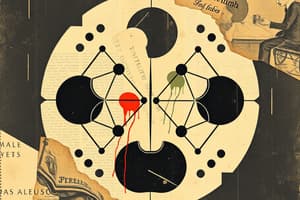Podcast
Questions and Answers
What is the primary purpose of mitosis?
What is the primary purpose of mitosis?
- Growth and repair (correct)
- Production of gametes
- Introduction of genetic variation
- Reduction of chromosome number
What occurs during the anaphase stage of mitosis?
What occurs during the anaphase stage of mitosis?
- Cytoplasm divides into two new cells
- Sister chromatids separate and move apart (correct)
- Chromosomes line up at the cell's center
- Chromosomes condense and become visible
How many daughter cells are produced by meiosis?
How many daughter cells are produced by meiosis?
- Four daughter cells (correct)
- Six daughter cells
- Two daughter cells
- Eight daughter cells
Which of the following stages occurs first in meiosis?
Which of the following stages occurs first in meiosis?
What is a key difference between daughter cells from mitosis and meiosis?
What is a key difference between daughter cells from mitosis and meiosis?
What is the function of crossing over in meiosis?
What is the function of crossing over in meiosis?
Which stage of mitosis involves the formation of spindle fibers?
Which stage of mitosis involves the formation of spindle fibers?
What happens to the chromosome number during meiosis?
What happens to the chromosome number during meiosis?
Flashcards are hidden until you start studying
Study Notes
Overview of Cell Division
- Cell division is essential for growth, repair, and reproduction in living organisms.
- It involves splitting a parent cell into daughter cells with identical genetic material.
Types of Cell Division
- Two primary types: mitosis and meiosis.
Mitosis
- Produces two genetically identical daughter cells.
- Responsible for growth, cellular repair, and asexual reproduction.
- Comprises four main stages:
- Prophase: Chromosomes condense, nuclear envelope breaks down, spindle fibers form.
- Metaphase: Chromosomes align at the cell's center, attached to spindle fibers.
- Anaphase: Sister chromatids separate and move to opposite ends of the cell.
- Telophase: Chromosomes uncoil, nuclear envelope reforms, cytoplasm divides, producing two daughter cells.
Meiosis
- Specialized cell division that produces gametes (sperm and egg cells).
- Results in four daughter cells, each containing half the chromosome count of the parent cell.
- Ensures offspring have the correct chromosome number post-fertilization.
- Introduces genetic variation via crossing over.
- Divided into two main stages:
- Meiosis I: Separates homologous chromosomes, creating two cells with half the chromosome count.
- Meiosis II: Separates sister chromatids, resulting in four cells with half the number of chromosomes.
Key Differences Between Mitosis and Meiosis
- Daughter Cells: Mitosis yields two identical cells; meiosis produces four diverse cells.
- Chromosome Count: Mitosis maintains the parent cell's chromosome number; meiosis reduces it by half.
- Purpose: Mitosis serves growth and repair; meiosis facilitates sexual reproduction.
Importance of Cell Division
- Cell division is vital for the continuity of life, affecting organism growth, development, and reproduction processes.
Studying That Suits You
Use AI to generate personalized quizzes and flashcards to suit your learning preferences.




